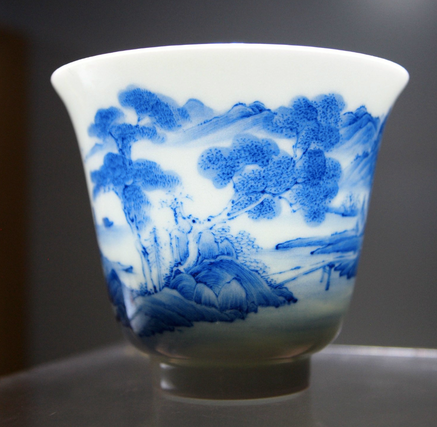4 Things to Know About Chinese Porcelain

(Originally published December 5, 2018)
This blog entry marks the beginning of our series on Chinese Porcelain; its characteristics, types, glazes and patterns. Before we focus on each of these subtopics, we begin as broadly as possible with 4 basic things you need to know about Chinese porcelain.
1) True Porcelain is impermeable and translucent.
Chinese porcelain manufactured in Jingdezhen is the original “hard paste” porcelain. All true porcelain – excluding bone china – is based on this recipe. The recipe for porcelain is a mixture of the materials kaolin 高岭土and petuntse 白墩子/瓷石 into a clay that is then shaped and fired at around 1300°C and over.
When porcelain is fired at or over 1300°C the petuntse vitrifies (becoming glass-like) and the kaolin provides strength, stability and its characteristic whiteness. Vitrification of the clay is an essential step in the manufacture of porcelain and it is vitrification which makes porcelain translucent and impermeable to water.
Low quality porcelain may be fired cheaply at much lower temperatures than 1300°C and will not undergo this important change. If you shine a light behind true porcelain that is not painted or glazed in an opaque color, you should be able to see the light glow through it. This is one method to check the quality of the material. Another method is checking to see whether unglazed areas of the porcelain object become permanently stained (by tea or dirt, etc.) or whether they can be easily cleaned. True porcelain that is high fired will be impermeable and will not stain under the surface; making it easy to clean. Low fired porcelain and fake porcelain will pick up permanent staining in unglazed areas.

Porcelain will glow when lit from behind.
2) Thinner is Better
Thin-walled porcelain is a sign of quality for the simple reason that it is more difficult to make. Very thin-walled porcelain is almost always fully-handmade as it is more difficult – and therefore more expensive – to make it using a machine process. Porcelain not shaped by hand is usually either made by a press or by pouring into a mould. In both cases the soft clay will show damage from this process if it is thin-walled. Imperfections on the surface are common when porcelain is made by pouring the liquified clay into a mould.

This factory-made cup was made by pouring liquified clay into a mould. The porcelain has numerous small bumps and imperfections.
3) Beware of Surface Painting on Antiques
Youshangcai 釉上彩 is the practice of painting on the surface of a glazed porcelain object. Youshangcai is perfectly acceptable if used on vases or other decorative objects or if it is from a trustworthy modern studio. The danger comes from the possibility of the paint containing (especially in antique pieces) harmful chemicals or heavy metals. Youzhongcai 釉中彩 (painting in between glazes) and youxiacai 釉下彩 (painting under the glaze) are safer as the paint is contained under the glaze.

The paintings are between the glazes in this Youzhongcai glazed porcelain teaset from Jingdezhen.
4) Form and function are equally important
Porcelain is one of the most versatile materials with which to fashion teaware. It can be shaped into a wide variety of shapes and its thickness can vary from very thick to egg shell thin. With such a versatile material, porcelain teaware can offer the best in terms of comfort, weight and ease of use.
Porcelain should be both beautiful and practical. Porcelain teaware should be comfortable to use, light for its size and feel well-balanced in the hand. Trust your feeling when deciding on a porcelain piece.

Chicken egg porcelain tea cups from Jingdezhen.
